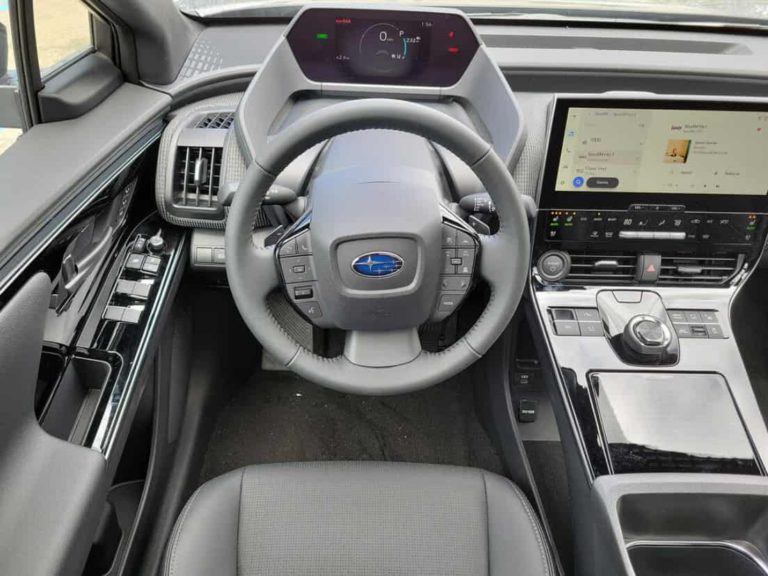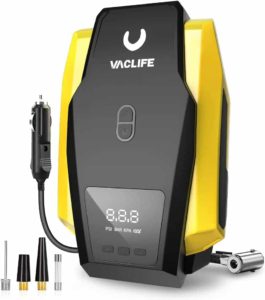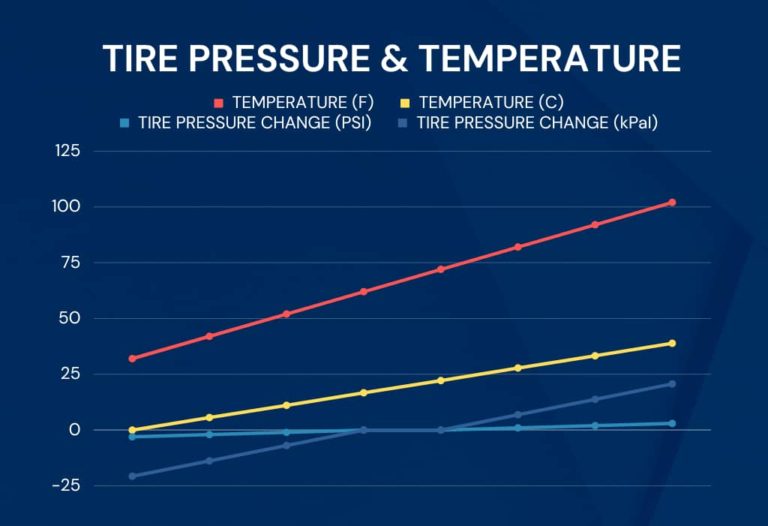What is the TPMS in the Subaru Solterra?
The tire pressure monitoring system (TPMS) in the Subaru Solterra is an integrated safety feature designed to keep the driver informed about the air pressure in each tire. When a tire’s pressure falls below the recommended level, the system triggers an alert on the vehicle’s dashboard, prompting the driver to take necessary action. This system serves as a crucial tool for maintaining optimal tire performance, fuel efficiency, and overall road safety. There are two kinds of tire pressure warnings in the Solterra. The first says “Adjust Pressure”. This warning is a normal warning that occurs from natural air loss or a change in outside temperature. The second is “Immediately Check Tire when Safe” is the emergency warning. This warning happens when there is a sudden loss of pressure like a puncture. To check your current tire pressure use your informational display. The pressure might take a few minutes of driving to display correctly.
Subaru Solterra Tire Pressure and Size
TIRE SIZE | FRONT PSI | REAR PSI |
235/60R18 | 38 | 38 |
235/50R20 | 38 | 38 |
SPARE TIRE | 60 | 60 |
Steps to Reset Subaru Solterra Tire Pressure Light
How to Reset Tire Pressure Light Using Current Pressure
Start the Solterra
Set the front and rear pressure to the recommended pressure levels
Press the up or down switches and select the settings icon (the gear)
Press the left or right switches and select “Vehicle Settings”
Press “Ok”
Press the up or down switches and select “TPMS Setting”
Press “Ok”
Press the up or down switches and select “Tire Pressure Setting”
Press “Ok”
Press the up or down switches and select “Setting by Current Pressure” then select “Ok”
Press the up or down switches and select “Ok” and then press “Ok” again.
The tire pressure warning light will blink 3 times and you’ll see a message saying that your tire pressure is being set and will be displayed.
How to Reset the Tire Pressure Light After a Tire Rotation
Park the Solterra and let it sit for 15 minutes or more
Start the EV system
Press the up or down arrow and select settings
Press the left or right buttons and select “Vehicle Settings”
Press and hold “Ok”
Press up or down and select “TPMS Setting”
Press “Ok”
Press the up or down switches and select “Tire Rotation”
Select “Ok”
Press up or down and select “Ok” and then press “Ok” again.
Message will appear that says “Setting Pressure Wait a Moment”
Drive your Solterra over 25 Mph for 15-30 minutes.
Repeat the procedure if needed.
How to Choose a Specific Tire Pressure Inflation Level
Start the Solterra
Press the up or down switches and select the settings icon (the gear)
Press the left or right switches and select “Vehicle Settings”
Press “Ok”
Press the up or down switches and select “TPMS Setting”
Press “Ok”
Press the up or down switches and select “Tire Pressure Setting”
Press “Ok”
Press the up or down switches and select “Setting by Specified Pressure” then select “Ok”
Choose your desired front and rear pressures
Press the up or down switches and select “Ok” and then press “Ok” again.
The tire pressure warning light will blink 3 times and you’ll see a message saying that your tire pressure is being set and will be displayed.
How Does the Subaru Solterra TPMS Work?
The tire pressure monitoring system (TPMS) in the Subaru Solterra uses a set of 4 sensors and software to monitor and maintain the optimal tire pressure for your vehicle. Here’s a breakdown of how it all works:
Sensors: Each tire, including the spare in some Solterra models, is equipped with a pressure sensor that is part of the valve stem. (on the inside of the tire) These sensors are battery-powered and their main purpose is to monitor the air pressure inside the tires. They work by measuring the air pressure and converting it into an electrical signal. Each sensor has a unique ID number.
Transmitter: Once the sensor measures the pressure, this information is sent to a transmitter that is integrated into the sensor assembly. The transmitter then sends a radio frequency signal containing the pressure information and unique sensor ID to the TPMS control module.
TPMS Control Module: This is the “brain” of the system, located within the vehicle. It receives the data sent from each of the tire pressure sensors. The module reads the pressure information, sensor ID and even sensor battery status from each tire and analyzes it.
Dashboard Indicator: If the pressure in any of the tires drops below a certain threshold (usually 10%-20% below the preset level), the TPMS control module will trigger a warning (exclamation point symbol) on the vehicle’s dashboard, alerting the driver that their tire pressure is too low. The Subaru Solterra also indicates which tire is underinflated on its data display.
System Self-check: Every time you start driving your Subaru Solterra it performs a self-check, ensuring that the system is functioning correctly and all sensors are communicating properly.
What is the TPMS Malfunction Indicator?
The Subaru Solterra’s tire pressure monitoring system also has a malfunction indicator to alert you when something is wrong with the system itself. This indicator uses the same yellow exclamation point as the low tire pressure light. The difference is that, if there is a problem with the system, the light will flash for approximately 60 seconds before staying on. The flashing or blinking will happen every time you start your EV until the issue is resolved. When your tire light is flashing your Solterra won’t know if your tires are low on pressure. Basically, a blinking tire pressure light means there is a malfunction within the TPMS itself, rather than an air pressure issue. This is usually due to a faulty pressure sensor in one of your tires (a dead battery) or driving with the spare tire. (if the spare doesn’t have a sensor in it) To determine which sensor is faulty, use a TPMS diagnostic tool and scan each sensor for diagnostic information.
Why is the Low Tire Light On?
What Will Cause the TPMS to not Work Properly?
Using non Subaru wheels
Using non Subaru tire sizes
If a window tint is installed, this can sometimes affect radio wave signals
If there is a lot of snow or ice on or around the tire valves
If the tire pressure is extremely high
If wheels without tire pressure sensors are installed on the car
If new tire pressure sensors are installed without registering the new sensor IDs with the Solterra’s computer
What are Common Causes for the Tire Pressure Light to Turn On?
Seasonal temperature changes: A drop in ambient temperature can cause tire pressure to decrease, triggering the warning light.
Tire puncture or leak: A sharp object or road debris like a nail or screw may puncture a tire, causing air loss which will of course activate the warning light.
Faulty tire pressure sensor: Damaged or malfunctioning sensors may provide inaccurate readings, resulting in a false alert. The only way to determine which sensor is faulty is to scan each sensor with a TPMS diagnostic tool.
Spare Tire: Driving with the spare tire or donut on your Solterra will make your tire light turn on.
Valve stem issues: A damaged or leaking valve stem can lead to gradual pressure loss and eventual activation of the tire pressure light. They make kits to replace the rubber gasket that usually goes bad.
Tire damage: Impact from potholes or hitting a curb can cause structural damage like tire bubbles, leading to pressure loss.
Sensor battery life: TPMS sensors are battery-powered, and over time, batteries die. (they usually last anywhere from 5-10 years) This will cause the tire pressure light to turn on. Again, you must use a diagnostic tool to determine which sensor is dead or dying.
Recent tire rotation or replacement: If the tires have been recently rotated or replaced, the TPMS may need recalibration to avoid false alerts. Sometimes the vehicle’s computer may think the front tires are in the rear and rear in the front after a rotation. Use the reset procedure above specifically for tire rotations.
Wheel or rim issues: Damaged, corroded, or cracked wheels or rims can lead to air leaks and pressure loss. This is very common with low profile tires.
Altitude changes: Climbing or descending in elevation can affect tire pressure and trigger the TPMS warning. An additional 1.5 Psi per Km above sea level is required.
Natural pressure loss: Tires lose air pressure over time due to temperature changes and permeation. Tire dry-rot will happen to tires that sit.
Electrical problems or software issues within the car’s TPMS system. Occasionally the system may have a software update from Subaru.
Snow Tires: If you have a separate set of wheels/rims for snow tires, either swap over the sensors from your summer wheels or purchase a second set of 4 sensors for the second set of wheels/rims. If you are using one set of wheels for both sets of tires, do not worry about this.
Tire Chains: The tire pressure system may not function correctly when you have tire chains installed.
What Happens When Tires are Underinflated?
Underinflated tires can have several impacts on your EV Solterra, including:
Reduced Range: Underinflated tires can increase rolling resistance, meaning the vehicle’s motor has to work harder to maintain speed. This extra work uses more energy, which can significantly reduce the range on a single charge.
Increased Wear: Tires that aren’t properly inflated tend to wear out quicker, particularly along the edges of the tread. This can lead to premature tire replacement.
Poor Handling: Underinflated tires can negatively affect the vehicle’s handling and performance. This can result in less responsive steering, and reduced stability and grip, particularly in sharp turns and sudden maneuvers.
Heat Build-Up: Underinflation can cause tires to overheat, especially at high speeds or in hot weather, which can result in tire failure or blowouts.
Lower Efficiency: As underinflated tires make the vehicle work harder, it results in lower energy efficiency, which is not optimal for an EV that relies solely on battery life.
Increased Charging Frequency: As the range decreases due to underinflation, the frequency of charging the EV will increase, leading to higher electricity costs and potential wear on the battery over time.
Impact on Regenerative Braking: Since underinflated tires affect the overall efficiency and performance of the vehicle, they might also reduce the effectiveness of regenerative braking.
What Happens When Tires are Overinflated?
Overinflated tires can also cause a range of problems:
Increased Wear: Overinflated tires tend to wear unevenly, particularly in the middle of the tread, which can lead to premature tire replacement.
Reduced Traction: Overinflation can reduce the tire’s contact with the road, leading to less grip and traction. This can result in poor handling and an increased risk of accidents, particularly in wet or slippery conditions.
Rough Ride: Overinflated tires do not absorb shocks from bumps and potholes effectively. This can lead to a less comfortable ride and potentially cause damage to the vehicle’s suspension.
Increased Risk of Tire Damage: Overinflated tires are more susceptible to damage such as punctures or blowouts, particularly when driving over rough or sharp objects. (nails or screws!)
Impaired Braking: With reduced traction, the braking distance may increase, affecting the vehicle’s ability to stop quickly in an emergency. Having to slam on your brake pedal will also wear out your brake pads and rotors faster.
Potential Impact on Regenerative Braking: Overinflated tires might also affect the efficiency of regenerative braking, a feature that helps recover and conserve energy, due to the reduced road contact and altered driving dynamics.
Noise and Vibration: Overinflated tires may cause lots of road noise and vibration while driving, leading to a less comfortable driving experience.
Does the Weather Affect Tire Pressure?
Weather plays a significant role in determining tire pressure due to the direct relationship between air temperature and pressure. As the temperature drops, air contracts causing a decrease in tire pressure. This is because the molecules inside the tire move slower and cluster closer together in colder conditions, reducing the pressure exerted on the tire’s side-walls. Conversely, in hot weather, the air inside the tire expands as the molecules move faster and spread out, increasing the tire’s internal pressure. Therefore, seasonal temperature changes can cause fluctuations in your vehicle’s tire pressure. This is a very common reason for your tire pressure light to come on! As a general rule, for every 10-degree drop in temperature, your tires can lose about 1-2 pounds of pressure.
How to Adjust Tire Pressure
Get a high-quality tire gauge.
Make sure to check the tire pressure when the tires are cold. “Cold” means your vehicle has been sitting for at least three hours or driven less than 1 mile in the past 3 hours.
Take off the valve cap from the tire valve stem.
Push the tire gauge firmly onto the valve to measure the pressure.
Compare the pressure reading with the recommended pressure on the tire information label.
If the pressure is lower than the recommended pressure, add air.
If the pressure is too high, let out some air by pressing the metal stem in the center of the tire valve. You can use any object like a screwdriver to do this. Be gentle.
Recheck the tire pressure with the gauge.
Don’t forget to put the valve caps back on to prevent leaks and keep dirt and moisture out.
When Should You Adjust Your Tire Pressure?
For a precise tire pressure reading on your Subaru Solterra, check it after the car has been parked for about 3 hours. This allows the tires to cool down. Checking after driving may give inflated readings due to heat causing the air in the tires to expand. Avoid adjusting tire pressure right after driving to prevent overinflation.
Conclusion
In conclusion, understanding and properly maintaining the tire pressure monitoring system in your Subaru Solterra is critical to your vehicle’s performance, safety, and energy efficiency. The TPMS is an advanced system that helps you keep track of your tire pressure and alerts you when it’s time to take action. Always remember to adjust tire pressure when the tires are cold, and follow the recommended pressure levels to ensure optimum vehicle performance. Everything in this article is applicable to all Subaru Solterra models and trims. Including, Solterra Premium, Solterra Limited, and Solterra Touring.






